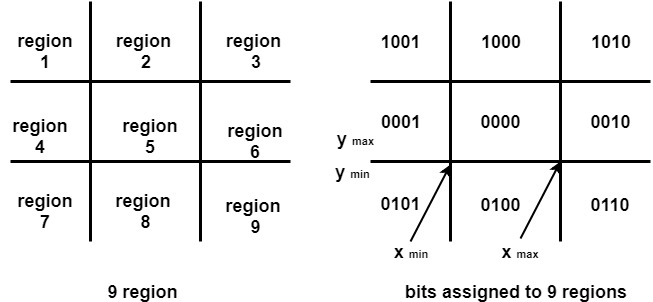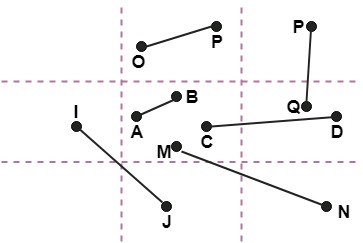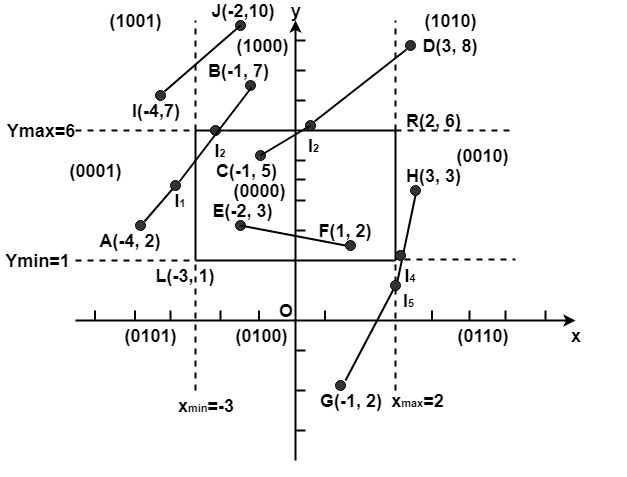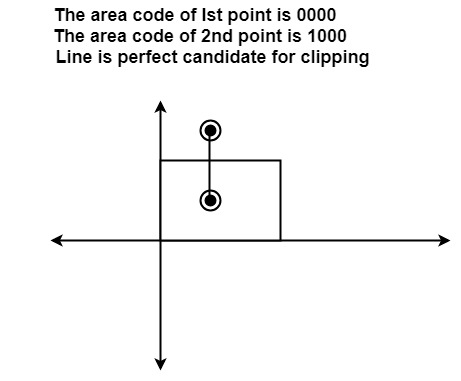Line Clipping:
It is performed by using the line clipping algorithm. The line clipping algorithms are:
- Cohen Sutherland Line Clipping Algorithm
- Midpoint Subdivision Line Clipping Algorithm
- Liang-Barsky Line Clipping Algorithm
Cohen Sutherland Line Clipping Algorithm:
In the algorithm, first of all, it is detected whether line lies inside the screen or it is outside the screen. All lines come under any one of the following categories:
- Visible
- Not Visible
- Clipping Case
1. Visible: If a line lies within the window, i.e., both endpoints of the line lies within the window. A line is visible and will be displayed as it is.
2. Not Visible: If a line lies outside the window it will be invisible and rejected. Such lines will not display. If any one of the following inequalities is satisfied, then the line is considered invisible. Let A (x1,y2) and B (x2,y2) are endpoints of line.
xmin,xmax are coordinates of the window.
ymin,ymax are also coordinates of the window.
x1>xmax
x2>xmax
y1>ymax
y2>ymax
x1<xmin
x2<xmin
y1<ymin
y2<ymin
3. Clipping Case: If the line is neither visible case nor invisible case. It is considered to be clipped case. First of all, the category of a line is found based on nine regions given below. All nine regions are assigned codes. Each code is of 4 bits. If both endpoints of the line have end bits zero, then the line is considered to be visible.

The center area is having the code, 0000, i.e., region 5 is considered a rectangle window.
Following figure show lines of various types

Line AB is the visible case
Line OP is an invisible case
Line PQ is an invisible line
Line IJ are clipping candidates
Line MN are clipping candidate
Line CD are clipping candidate
Advantage of Cohen Sutherland Line Clipping:
- It calculates end-points very quickly and rejects and accepts lines quickly.
- It can clip pictures much large than screen size.
Algorithm of Cohen Sutherland Line Clipping:
Step1:Calculate positions of both endpoints of the line
Step2:Perform OR operation on both of these end-points
Step3:If the OR operation gives 0000
Then
line is considered to be visible
else
Perform AND operation on both endpoints
If And ≠ 0000
then the line is invisible
else
And=0000
Line is considered the clipped case.
Step4:If a line is clipped case, find an intersection with boundaries of the window
m=(y2-y1 )(x2-x1)
(a) If bit 1 is “1” line intersects with left boundary of rectangle window
y3=y1+m(x-X1)
where X = Xwmin
where Xwminis the minimum value of X co-ordinate of window
(b) If bit 2 is “1” line intersect with right boundary
y3=y1+m(X-X1)
where X = Xwmax
where X more is maximum value of X co-ordinate of the window
(c) If bit 3 is “1” line intersects with bottom boundary
X3=X1+(y-y1)/m
where y = ywmin
ywmin is the minimum value of Y co-ordinate of the window
(d) If bit 4 is “1” line intersects with the top boundary
X3=X1+(y-y1)/m
where y = ywmax
ywmax is the maximum value of Y co-ordinate of the window
Example of Cohen-Sutherland Line Clipping Algorithm:
Let R be the rectangular window whose lower left-hand corner is at L (-3, 1) and upper right-hand corner is at R (2, 6). Find the region codes for the endpoints in fig:

The region code for point (x, y) is set according to the scheme
Bit 1 = sign (y-ymax)=sign (y-6) Bit 3 = sign (x-xmax)= sign (x-2)
Bit 2 = sign (ymin-y)=sign(1-y) Bit 4 = sign (xmin-x)=sign(-3-x)
Here

So
A (-4, 2)→ 0001 F (1, 2)→ 0000
B (-1, 7) → 1000 G (1, -2) →0100
C (-1, 5)→ 0000 H (3, 3) → 0100
D (3, 8) → 1010 I (-4, 7) → 1001
E (-2, 3) → 0000 J (-2, 10) → 1000
We place the line segments in their appropriate categories by testing the region codes found in the problem.
Category1 (visible): EF since the region code for both endpoints is 0000.
Category2 (not visible): IJ since (1001) AND (1000) =1000 (which is not 0000).
Category 3 (candidate for clipping): AB since (0001) AND (1000) = 0000, CD since (0000) AND (1010) =0000, and GH. since (0100) AND (0010) =0000.
The candidates for clipping are AB, CD, and GH.
In clipping AB, the code for A is 0001. To push the 1 to 0, we clip against the boundary line xmin=-3. The resulting intersection point is I1 (-3,3

For clipping CD, we start with D since it is outside the window. Its code is 1010. We push the first 1 to a 0 by clipping against the line ymax=6. The resulting intersection I3 is (
For clipping GH, we can start with either G or H since both are outside the window. The code for G is 0100, and we push the 1 to a 0 by clipping against the line ymin=1.The resulting intersection point is I4 (2
Program to perform Line Clipping using Cohen Sutherland Algorithm:
Output:

